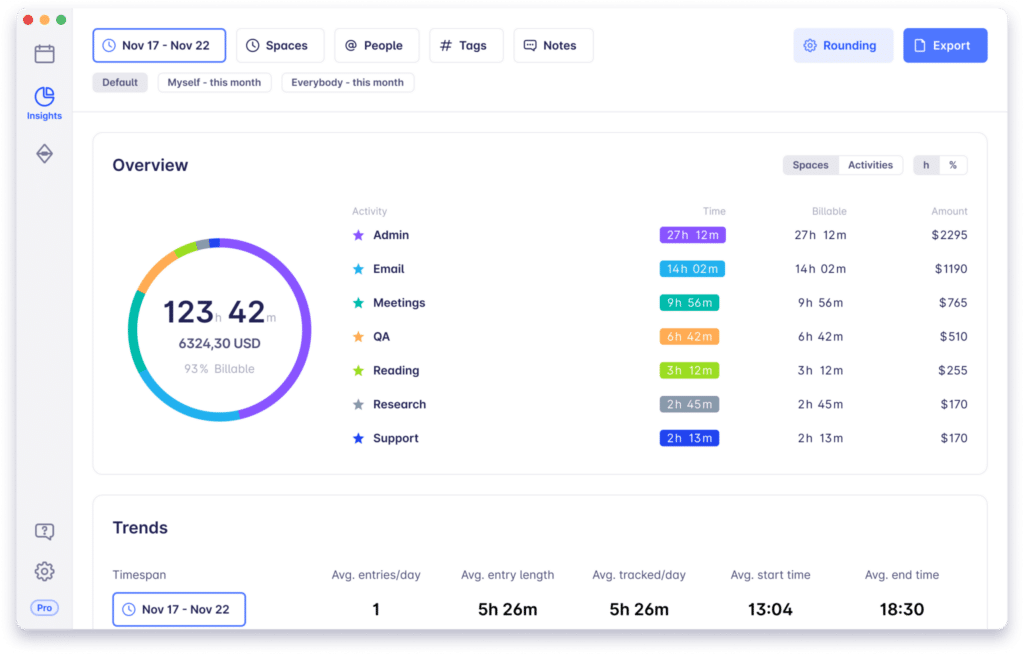Work Overload: Expert Tips to Tackle and Prevent it
You have only 24 hours a day. How much can you squeeze in? Is there already too much on your to-do list? How to deal with work overload in your team? Let’s discuss it together.
In this article, we’ll explore:
What is work overload
How to recognize work overload
How work overload impacts individuals and entire organizations
How to avoid personal work overload and employee overload

“I’ve doubled my revenue thanks to Timeular and managed to halve how much I work.” – Valdemar Alfred, Owner of Valdefar
What is work overload?
Work overload is a situation when the number of tasks required for a job exceeds your capacity, leading to stress and time anxiety.
According to the Encyclopaedia of Public Health, “Work overload happens when job demands exceed an individual’s ability to deal with them; i. e. exceed the time and resources available.”
“Work overload represents the weight of hours, the sacrifice of time, and the sense of frustration with the inability to complete tasks in the time given. Long working hours, particularly at the expense of other parts of workers’ lives, help to create overload. Added to long hours is the sense that there is too much to do in too little time.”
Types of work overload
Qualitative overload occurs when a person lacks the necessary skills to do their job, so they work beyond their capabilities.
Quantitative overload is closely related to how people spend time – a person may have the skills but not the hours to do the job.
What are the most common signs of work overload?
High-stress levels: Excessive workload is one of the main causes of stress at the workplace. People experience increasing levels of stress in their daily lives. This has an extremely negative impact on physical and mental health.
Persistent exhaustion: A persistent state of decreased energy becomes prevalent, which can have an impact on overall energy levels, motivation, and, as a result, on productivity.
Productivity loss: A significant reduction in the quantity of work produced and poor quality work delivered.
Missing deadlines: Missed deadlines often occur due to individuals being assigned more tasks than they can realistically complete within the given timeframe, leading to over-commitment and time management challenges.
Feeling of overload: Workers feel a constant sense of being overwhelmed with too many tasks and can’t stay focused.
Related content: Signs of being stressed at work
Track time spent on specific tasks and keep track of your workload with ease.
What are the causes of work overload?
Setting unrealistic deadlines: Setting deadlines that are too tight and unrealistic creates a constant sense of urgency, which contributes to becoming overloaded.
Excessive workload: Allocating more tasks than a person can reasonably complete in a given time
is a common issue.Inadequate delegation: Poor management of the distribution of responsibilities within a team results in an uneven distribution of workload.
Lack of defined business priorities: Workload overload can result from a lack of defined business priorities, underlining the importance of setting clear and strategic objectives for effective workload management.
Job insecurity fears: Employees who fear losing their jobs may silently endure excessive workloads without acknowledging the strain.
Challenges of remote working: While the new remote world offers flexibility, it may not reduce actual workload or stress. Some organizations increase control through invasive monitoring programs.
Cultural identity at work: The definition of self-worth in terms of professional roles makes it difficult to refuse additional responsibilities.
Individual motivations: Some people are overworked because of personal life aspirations, such as climbing the social ladder or outdoing their parents.

“We saw Timeular as a great opportunity to put some joy into time tracking.” – Ricardo Hödebeck, Marketing Manager at aletto Hotels
Examples of work overload
Before starting a job, most of us have probably experienced being overwhelmed with too much work, like when we had loads of homework and assignments in school. But what happens when we’re working a full-time position? Let’s examine some similar situations in the professional world.
Example 1: David’s Midnight Marathon
David is known for consistently working late into the night to tackle projects long after others have left the office. This dedication has made him a familiar face to the night security staff and has become a routine that extends far beyond regular business hours, taking a huge toll on his and his family’s personal lives.
Example 2: Sophie’s Never-Ending Email Expedition
Sophie is one of many hardworking team members. She is always available through her inbox. Even after her official working hours end, she remains immersed in answering emails and working remotely. Her dedication to staying connected blurs the lines between work and personal time.
Example 3: Michael’s Commute Puzzle
Michael has a very challenging workload. He turns his daily commute into a mobile office. He’s often the last to leave the car park. He uses his time in the car to catch up on various tasks and prepare for the day ahead. His commitment to his work extends beyond the confines of the office, affecting his life-work balance.
- Recommended read: How many work days in a year?

“It’s important for us to have the ability to review our workload and ensure that time is spent in the right places.” – Senior Designer at O’Brien Media
The impact of work overloading on the employee
Occasional overtime may seem harmless. However, when having overworked employees becomes a daily norm, the effects are significant in the employee’s personal life. Here are some of the physical health issues:
Insomnia: According to a study available on MedicalNewsToday, elevated stress levels lead to an increased cortisol response, disrupting sleep cycles and affecting concentration the next day.
Burnout and stress: Excessive work contributes to burnout, now recognized by the World Health Organization as an “occupational phenomenon.”
Anxiety: Work-related stress induces feelings of guilt, shame, and self-doubt, leading to elevated anxiety levels, according to a study by the National Library of Medicine.
Heart disease risk: Research indicates a 60% increase in the risk of heart disease with just 3 to 4 extra hours of work per day.
Diabetes risk: Many studies also show that working 55+ hours per week is linked to a higher incidence of Type 2 diabetes.
TIP: To calculate overtime, use our free Overtime Calculator.

“This is really helpful with resource planning as it shows us who has capacity and who has upcoming time off.” – Justus Fischer, Founding Partner at Via Tomorrow Consulting
The impact of work overloading on the team
Work overload doesn’t just affect individuals; it permeates throughout the entire team. Here are some of the negative aspects:
Decreased work quality: Overworked employees may cut corners, affecting the overall productivity of team members.
Team conflict: Fatigue and exhaustion can lead to increased irritability. This can cause conflict and hinder communication.
Time pressure: With a growing backlog of tasks to complete, an overworked employee can feel significant time pressure. People tend to cut corners, skip final checks and move a little faster than they should when they feel under constant pressure.
Increased employee switch: Burnout contributes to high turnover rates, leaving remaining team members overworked and perpetuating a cycle of understaffing.
Reputation damage: Work overload reflects poorly on the workplace culture. It damages the employer’s brand and lowers standards for customers.
Track time spent on specific tasks and keep track of your workload with ease.
Read: How to create a high performing team
How to check if a team member is overloaded
It may seem easy to spot signs of employee overload. However, the challenge lies in employees’ reluctance to show vulnerability.
Wanting to make a positive impression and fearing potential repercussions, such as missed promotions or unfavorable performance reviews, many hide the true extent of their workload.
So how can you effectively assess whether they are struggling to cope with working too much?
1. Encourage open dialogue
Foster a psychologically safe environment where people feel comfortable talking about how they’re feeling.
Encourage regular check-ins and make it clear that honest communication is valued over a facade of perpetual capability.
2. Use anonymous pulse surveys
To gather candid feedback on employee satisfaction and workload, conduct anonymous pulse surveys.
This allows employees to share their experiences without fear of repercussions and provides valuable insight into the prevailing work environment.
3. Monitor the workload metrics
Keep a close eye on workload-related key performance indicators (KPIs) such as task completion rates, overtime hours per employee, and individual capacity.
You can gain quantitative insight into the distribution and impact of work across the team by tracking these metrics.
- You might find it helpful: Time reporting system
4. Watch for changes in behavior
If you’ve noticed once happy and motivated employees starting to look lethargic and disengaged, you may want to investigate. Also, if an employee who used to work well and on time gradually starts slowing down and fail to complete tasks, overload could be the cause.
Paying close attention to changing moods and energy can provide valuable clues.
5. Attendance and punctuality
Monitor attendance and punctuality regularly. Work overload often prevents you from achieving balance. This can lead to increased absenteeism or lateness.
A noticeable change in these patterns may be a sign of an overwhelmed workforce. To help you with this, you can use a workforce management software.
6. Action on feedback
Act on feedback. Take proactive steps to address issues when employees express concerns or report feeling overwhelmed.
Demonstrating that their feedback will not only be listened to but also acted upon will build trust and encourage openness in the future.

Read: How to improve team performance
How to avoid employee overload and promote team wellbeing
Tackling the challenges of work overload requires strategic interventions to ensure the well-being and productivity of your team. If you’re a manager, this may feel daunting, but there are actionable strategies that can have a significant impact, such as:
1. Recognize individual skills
Recognize individual skills for tailored workloads. Use a detailed task map and objective evaluation tools for effective workload management.
Do a workload analysis and create a detailed map of daily tasks for a holistic understanding.
- Use time-tracking tools such as Timeular to assess workload. Note that manual timesheets might cause friction and create overwhelm.
2. Encourage assertiveness, transparency, and communication boundaries
Even though every job is different, nearly every job has to have boundaries. Create an environment where team members feel empowered to communicate limitations and set specific times for sending and responding to emails or phone calls.
Encourage team members to be assertive about limitations and set boundaries. If needed, teach them how to say no at work. One of the easiest ways to do this is to create a weekly time budget and then show it to those who ask for more of your time.
Foster a culture of honesty and respect for workload constraints.
Establish communication policies to prevent overwork beyond business hours and promote work-life balance.
Change company culture to have clear expectations about when and how team members will be contacted.
Read also: How to improve communication skills at work
3. Set clear goals and plans
Define success for effective collaboration. Prioritise tasks and create detailed plans to reduce the risk of work overload.
Clearly define success for each project or task.
Work together to prioritize tasks based on importance.
Develop detailed plans with actionable steps, deadlines, and built-in time for reassessment.
You may also like: 6 Reasons Why It Is Important To Set Realistic Goals
4. Implement time-budgeting
Treating time as a valuable resource emphasizes its efficient use. Time blocking and real-time tracking tools help manage time effectively and prevent unnecessary workload accumulation.
Emphasise time as a valuable resource, similar to financial budgeting.
Use time blocking to allocate specific blocks of time to each project. (TIP: Read our guide on “How to budget time“)
Use time-tracking software such as Timeular for real-time tracking.
Read also: Time tracking for project management
5. Streamline unnecessary meetings to increase productivity
Optimize the efficiency of meetings to prevent tiring zoom fatigue. Asynchronous tools provide the flexibility to share information without time constraints, reducing cognitive fatigue.
Address Zoom fatigue by presenting to team members asynchronous tools such as Slack or Loom.
Reduce reliance on real-time meetings to avoid cognitive fatigue.
You might be interested in: Slack time tracking
6. Encourage single-tasking for efficiency
Increase individual efficiency by prioritizing tasks and minimizing context switching. Whatever you can do to focus on one task at a time will help reduce the panic and anxiety associated with overload. Productivity suffers because of the time lost switching between too many tasks or constantly checking what’s burning the brightest.
- Encourage a prioritized to-do list to increase efficiency and productivity. Note that productivity differs from efficiency.
Minimize context switching to maintain focus and productivity.
7. Promote mental health care
According to a mental health research report published in the American Psychological Association, companies that address mental health concerns report increased employee satisfaction and retention.
Be a champion of mental health support.
Lead by example by prioritizing self-care.
Promote a supportive work environment to encourage open discussions about self-care.

8. Stress management techniques for work overload
Mindfulness and meditation techniques
- Mindfulness techniques: Incorporate mindfulness practices into your daily routine, such as mindful breathing or body scan exercises.
- Meditate regularly: Set aside time for meditation sessions. This promotes a calm and centred mind. Guided meditation apps or classes can provide structured support for those new to meditation.
- Mindful work breaks: Integrate short mindful breaks into the workday to allow for moments of relaxation and mental reset.
Read also: How to increase focus and concentration
Physical activity and relaxation techniques
- Exercise: Regular physical activity, like jogging, yoga, or a brisk walk during breaks, releases endorphins, reduces stress hormones, and enhances overall physical health and mood.
- Do progressive muscle relaxation (PMR): To release tension from being constantly stressed, practice PMR. Systematically tense and then relax different muscle groups, promoting physical relaxation.
- Exercises for deep breathing: Incorporate techniques, such as diaphragmatic or box breathing, to calm the nervous system and reduce the physiological effects of stress.
Seek support
- Maintain an open line of communication with colleagues and your manager: Share workload concerns with trusted colleagues to gain perspective and potential support, and foster a supportive work environment conducive to collaborative problem-solving. Also, if you feel that your manager has given you too much work and the deadlines don’t seem reasonable, politely explain that you feel overwhelmed.
- Support from friends and family: Outside of work, share feelings of being overwhelmed with friends and family to gain emotional support, providing a broader perspective and alleviating stress through understanding and empathy.
- Seek professional support: Consider discussing work-related stress with a professional, like a counselor or therapist, who can provide coping strategies, stress management techniques, and a confidential space to address deeper emotional challenges.
Related content: How to deal with stress at work
9. Time management and priority setting
- Effective time management: Use time-blocking techniques to organize and prioritize tasks. Allocate specific blocks of time to focus and break down large projects into smaller, more manageable tasks, to avoid work overload.
- Prioritizing tasks: Identify and prioritize tasks based on urgency and importance. This helps to focus energy on high-priority items, reducing the feeling of being overwhelmed by an extensive task list.
- Set realistic goals: It’s important to set realistic goals to manage expectations. Unrealistic goals can contribute to stress, while achievable milestones provide a sense of accomplishment.
10. Setting boundaries
- Set work-life balance boundaries: Clearly define the boundaries between work and personal life. Avoid extending work hours into personal time and vice versa. Prioritize work-life balance that supports overall well-being.
- Digital detox: Schedule regular breaks from digital devices to disconnect from work-related communication. This break allows for mental rejuvenation. It also reduces the constant influx of work-related information.

11. Use effective communication and collaboration strategy
- Clear communication: Make sure that the communication within your team is clear, concise, and easy to understand. Miscommunication can lead to unnecessary work and delays.
- Check-in regularly: Schedule regular team meetings to discuss progress, challenges, and upcoming tasks. This keeps everyone on track and helps address issues promptly.
- Use collaboration tools: Use team communication apps like Slack or Microsoft Teams, and project management platforms like Jira or Asana for more streamlined team cooperation.
TIP: Learn how to improve team communication
12. Use technology and productivity tools
- Time-tracking: Implement time-tracking tools like Timeular to monitor and analyze how you spend your working hours. It helps identify time wasters, minimize distractions, and allows you to allocate time more efficiently. If you’re looking for ways to be efficient, check out our article on how to be more efficient.
- Task management apps: Use a team workload management tool to organize and prioritize your tasks. Break down large projects into smaller, manageable tasks to make it easier.
- Automation tools: Identify repetitive tasks that can be automated using tools like Zapier. Automation frees up time for the more critical and creative aspects of your work. (TIP: Read our post and find out some of the best task automation software.)
Tip: Team productivity can be achieved with the top team productivity tools.
13. Streamline processes and optimize workflows
- Process evaluation: Regularly evaluate your processes, identifying bottlenecks and areas for improvement at work, as this objective assessment helps identify stress sources and allows for the reordering of priorities.
- Set realistic goals: Break down your work into achievable goals and set realistic deadlines. This will prevent you from feeling overwhelmed. (You might be interested in the article: How to set realistic goals)
- Continuous improvement: Foster a culture of continuous improvement within your team. Ask for feedback regularly, analyze performance metrics, and implement changes to optimize workflows.
How to manage employee overload with Timeular
Employee overload is a common challenge for managers, and tackling it requires a proactive approach to time management techniques.
Harnessing the power of tools like Timeular can be the key to understanding employee capacity and creating balanced workloads that empower rather than overwhelm your workforce.

By embracing technology, you can effectively support employee performance and well-being, streamline processes, and optimize productivity.
With Timeular, your team can benefit from automated time tracking that provides you with valuable insights and concrete data on how your team allocates their time. They also provide valuable metrics that allow employees to identify areas for improvement and reclaim valuable time.
The beauty of this solution lies in its simplicity. With no manual time tracking required, your team can focus on creating higher-value work for both their personal growth and the success of your business. It’s a mutually beneficial arrangement that fosters a culture of productivity and satisfaction!
Conclusion
In conclusion, recognizing and addressing work overload is essential for both individual well-being and overall team productivity.
By making well-being a priority, individuals can take a proactive approach to managing stress, building resilience, and fostering a more sustainable and fulfilling work experience.
To create a healthier and more balanced work environment, take small steps toward it, as suggested in our post.
FAQ
How can I manage employee overload effectively?
To manage work and avoid employee overload more effectively, prioritize and delegate tasks when possible, use time management tools, and communicate with your team.
Is work overload bullying?
Work overload is not in itself a form of bullying, but excessive and prolonged work overload without support or consideration can contribute to a stressful and unhealthy working environment.
What are the signs of employee overload?
Common signs of work overload may include ongoing fatigue, missed deadlines, decreased productivity, more frequent errors, and heightened stress levels. We’ve written a comprehensive guide on how stress affects productivity if you’d like to dive deeper into this topic.
How does employee overload affect mental health?
Work overload can lead to anxiety, burnout, and other mental health problems due to prolonged stress, lack of work-life balance, and feeling overwhelmed by having too many tasks.
You might be interested in: